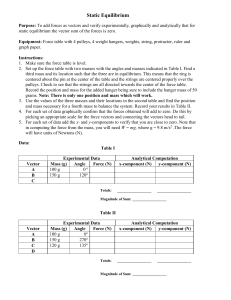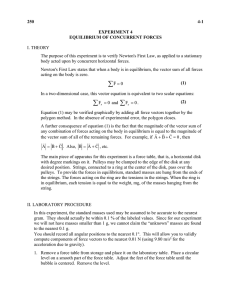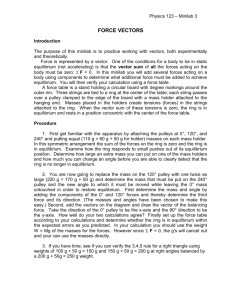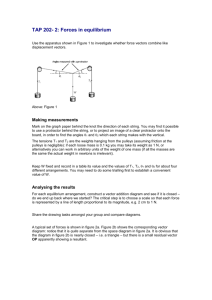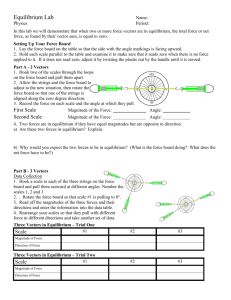Equilibrium of Concurrent Forces
advertisement
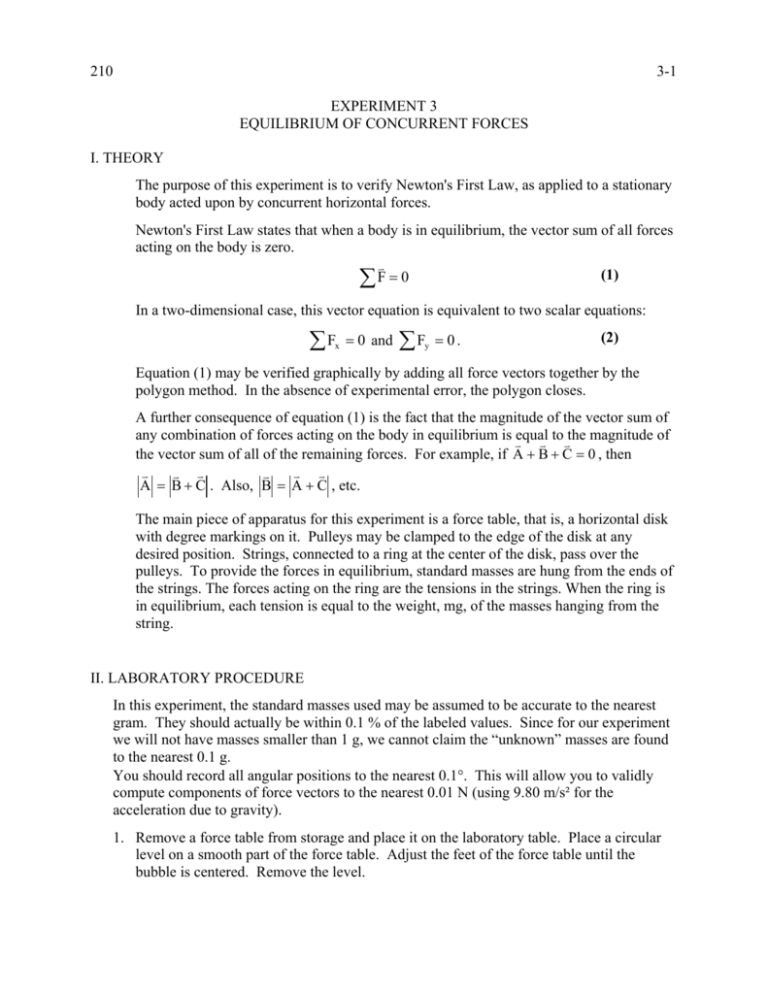
210 3-1 EXPERIMENT 3 EQUILIBRIUM OF CONCURRENT FORCES I. THEORY The purpose of this experiment is to verify Newton's First Law, as applied to a stationary body acted upon by concurrent horizontal forces. Newton's First Law states that when a body is in equilibrium, the vector sum of all forces acting on the body is zero. v (1) ∑F = 0 In a two-dimensional case, this vector equation is equivalent to two scalar equations: ∑F x = 0 and ∑F y = 0. (2) Equation (1) may be verified graphically by adding all force vectors together by the polygon method. In the absence of experimental error, the polygon closes. A further consequence of equation (1) is the fact that the magnitude of the vector sum of any combination of forces acting on the body in equilibrium is vequal to the magnitude of v v the vector sum of all of the remaining forces. For example, if A + B + C = 0 , then v v v v v v A = B + C . Also, B = A + C , etc. The main piece of apparatus for this experiment is a force table, that is, a horizontal disk with degree markings on it. Pulleys may be clamped to the edge of the disk at any desired position. Strings, connected to a ring at the center of the disk, pass over the pulleys. To provide the forces in equilibrium, standard masses are hung from the ends of the strings. The forces acting on the ring are the tensions in the strings. When the ring is in equilibrium, each tension is equal to the weight, mg, of the masses hanging from the string. II. LABORATORY PROCEDURE In this experiment, the standard masses used may be assumed to be accurate to the nearest gram. They should actually be within 0.1 % of the labeled values. Since for our experiment we will not have masses smaller than 1 g, we cannot claim the “unknown” masses are found to the nearest 0.1 g. You should record all angular positions to the nearest 0.1°. This will allow you to validly compute components of force vectors to the nearest 0.01 N (using 9.80 m/s² for the acceleration due to gravity). 1. Remove a force table from storage and place it on the laboratory table. Place a circular level on a smooth part of the force table. Adjust the feet of the force table until the bubble is centered. Remove the level. 210 3-2 2. Insert the center pin in the hole in the center of the force table. Place the ring, with five strings attached, over the center pin. Clamp pulleys at 20.0° and 110.0°. Run strings over the pulleys and attach weight hangers. Add masses to the pulleys so that the total masses are: A = 260 g at 20.0° and B = 340 g at 110.0°. These masses include the mass of the weight hanger; that is, mass A consists of the 50 g weight hanger plus 210 g. By trial and error, find the one additional mass C which will produce equilibrium, with the ring at the center of the force table. You will have to vary both the position of the pulley for mass C and the amount of mass used. Record the mass C and the angular position of the pulley along with the given masses A and B and the angular position of the corresponding pulleys. Because of pulley friction, it is impossible to find this mass exactly. That is, the ring will remain at rest when released at slightly different off-center positions. However, when the ring remains at rest when released at points located equal distances in any direction from the center, the correct mass C may be considered to have been found. Smaller masses of 1, 2 and 5 g are available in addition to the masses found in the weight sets. 3. Set up the following masses: D = 380 g at 40.0° and E = 440 g at 145.0°. By trial and error, find the one additional mass F which produces equilibrium. Record all the masses and the angular position of the corresponding pulleys. 4. Return the 1, 2 and 5 g masses to their storage box. Put the weight sets in order: 500, 2200, 100, 50, 2-20 and 10 g. Place the center pin and the ring with attached strings in the provided bag. Return the force table to storage. III. CALCULATIONS 1. Draw a set of axes and mark the angular positions 0°, 90°, 180°, and 270°; these are the positive x, positive y, negative x, and negative y directions respectively. Draw in the vectors A and B, with their tails at the origin and in their correct directions. Make the lengths of the vectors proportional to the force magnitudes; choose a scale, such as 1 cm represents 0.01 N, so that the diagram takes up a large portion of the page. Using parallelogram addition, draw in the vector sum. Also draw in a vector which is equal and opposite to the vector sum. This is the expected force C. 2. Referring to the diagram, note that vectors A and B are perpendicular to each other. Use the Pythagorean Theorem to calculate the magnitude of the vector sum of A and B. This should theoretically be equal and opposite to the force C. Calculate the percent difference between the magnitude of this calculated vector sum of and A and B and the magnitude of the force C determined from the mass measured in lab. 3. Referring to the same diagram, use trigonometry to calculate the angle between the vector A and the vector sum of A and B. Label this angle in the diagram. From this angle, calculate the expected angular position of force C. Calculate the difference between this angle and the angular position of force C measured in lab. 210 3-3 4. On a separate sheet of unlined paper, add the vectors D, E, and F together by the polygon method as follows: Choose a scale, for example 1 cm represents 0.01 N, so that the polygon covers a substantial part of the sheet. Draw a set of X and Y axes. Use a protractor to draw a line from the origin in the direction of vector D. Use a ruler to mark off a length corresponding to the magnitude of the vector, using your chosen scale. Place an arrowhead at the tip of this line. Use a protractor to draw a line from the tip of vector D in the direction of vector E, using the interior angle on the polygon (see figure below). You will have to calculate the interior angle. Repeat this process with the remaining vectors. Next to each vector record its name (such as D), its magnitude in newtons, and its angle, as recorded on the data sheet. Measure the distance by which the polygon fails to close, and convert the distance into newtons. Apart from rounding and procedural errors, this force represents pulley friction. E, 4.31 N at 145.0° angle E angle D angles measured with protractor to construct figure y D, 3.72 N at 40.0° x 5. Make a table with the following columns: force label (D, E, and F), magnitude (in N), angle, x-component, and y-component. Fill in the table with the appropriate values for forces D, E, and F. Show the calculation of the components for force D. Calculate the algebraic sums of the x and y components. Is Newton’s First Law (equations (2)) verified within experimental error?

